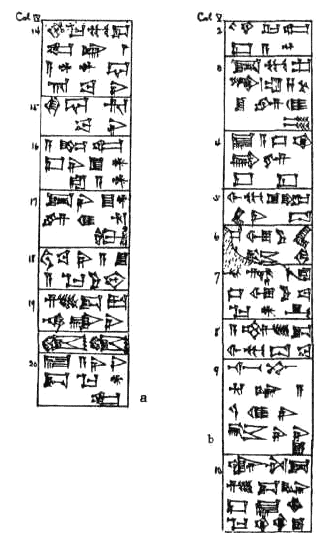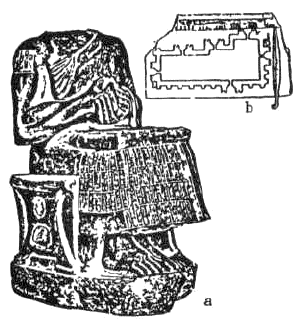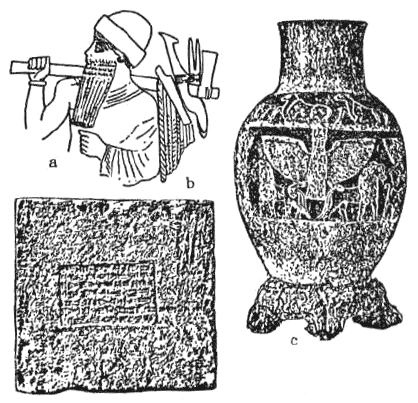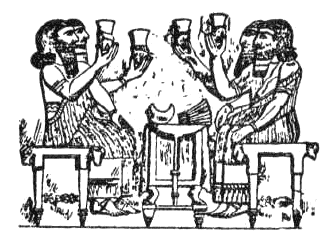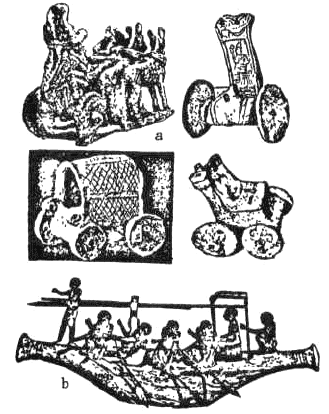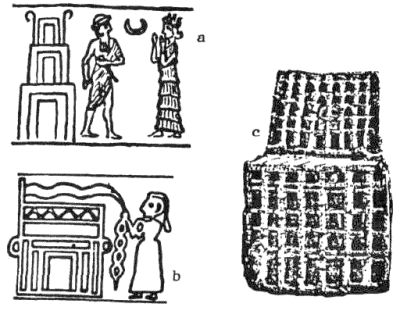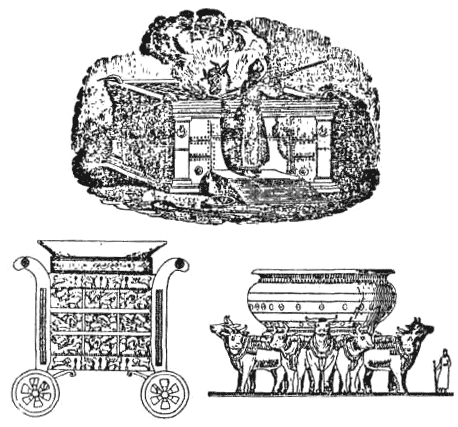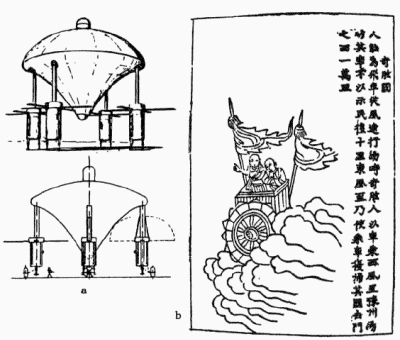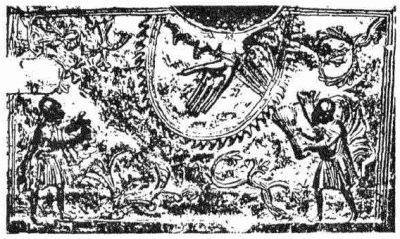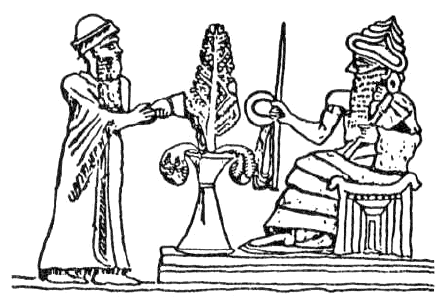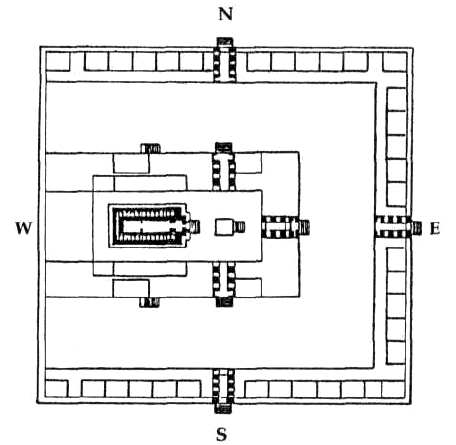|
As all other aspects of the imagined and unreal episode, the object too had to be imagined and nonreal. But as the viewer and the hero are certain that all had faded into its nonreality, the hero finds the object in his pocket or on his finger - a reality left over from the unreality. And thus, Rod Serling has shown us, between reality and nonreality, between the rational and the irrational, we were passing through a Twilight Zone.
As it turned out, Ninurta’s plan was to build in Mesopotamia a most unusual temple, one that would emulate the Great Pyramid of Giza on the one hand and that, upon its vast platform, would hold stone circles that could serve as sophisticated astronomical observatories. The need to find a reliable and faithful worshiper to carry out the grandiose plans and to follow intelligently the designs of the Divine Architects served as the background for the ensuing events recorded by Gudea.
Figure 59a and Figure
59b Utterly perplexed by the occurrence, Gudea asked for and received permission to seek the advice of the oracle Goddess Nanshe in her "House of Fate-Solving" in another city. Reaching the place by boat and offering prayers and sacrifices so that she would solve the riddle of his nighttime vision, Gudea proceeded to tell her what had happened (we read from column IV in Cylinder "A," verses 14-20, as transcribed by Ira M. Price, The Great Cylinder Inscriptions A and B of Gudea, Fig. 59a):
A celestial omen then followed whose meaning, Gudea told the dream-solving Goddess, he did not understand: the Sun upon Kishar (the planet Jupiter) was suddenly seen on the horizon.
A female then appeared and gave Gudea celestial instructions (column IV, verses 23-26):
As the "woman" was consulting the star tablet, a third divine being appeared (we follow column V, verses 2-10, Fig. 59b); he was a male:
The text suggests that all these objects somehow materialized during the dream, but regarding one of them there is absolutely no doubt that it was made to cross from the dream dimension to the dimension of physical reality; for when Gudea awoke, he found the lapis lazuli stone tablet on his lap, with the plan of the temple etched upon it. He commemorated the miracle in one of his statues (Fig. 60a).
Figures 60a and 60b
The statue shows both the tablet and the Divine Stylus
with which the plan was etched. Modern studies suggest that,
ingeniously, the markings on the margin (Fig. 60b) are diminishing
scales
for constructing all of the seven stages of the temple with one
single design.
Figures 61a. 61b, and 61c
Repeating the details of the dream-vision one by one in the manner
reported by Gudea, the oracle Goddess proceeded to tell the king
what it meant. The first God to appear, she said, was
Ninurta/Ningirsu, announcing to Gudea that he was chosen to build
the new temple: "For thee to build his temple he commanded." Its
name was to be E.NINNU - "House of Fifty" - to signify that Ninurta has
the claim to Enid’s rank of fifty and thus the only one below Anu,
whose rank was sixty. The sighting of the heliacal rising of Jupiter "is the God Ningishzidda," meant to show the king the exact point in the skies to which the temple’s observatories should be oriented, indicating precisely where the Sun will rise on the day of the New Year.
The female who appeared in the vision, carrying on her head the image of a temple-structure, was the Goddess Nisaba; with her stylus that she grasped in one hand and the celestial map that she held in the other hand, "to build the temple in accordance with the Holy Planet she instructed thee." And the second male, Nanshe explained, was the God Nindub; "to thee the plan of the temple he gave."
Still perplexed, he went into the temple’s Holy of Holies and appealed to "Ningirsu, son of Enlil," for additional guidance:
He asked for a second omen, and received it. In what scholars call Gudea’s second dream, the position of the king and the encountered deity seem to be crucial. The text (column IX, verses 5-6) states that "for the second time, by the prostrate one, by the prostrate one, the God took his stand." The Sumerian term used, NAD.A, conveys more than the "lying (lat, lying stretched out" that the English term "prostrate" conveys. It implies an element of not-seeing by lying facedown. Gudea, in other words, had to lie down in a manner assuring that he would not see the deity.
The God, on his part, had to position himself at the head of Gudea. If Gudea was asleep, or in a trance, did the God actually speak to him - or was the position near the king’s head intended to facilitate some other, metaphysical method of communication? The text does not make this point clear; it does relate that Gudea was given promises of constant divine help, especially by the God Ningishzidda.
The help of this deity, whom we have identified as the Egyptian deity Thoth, seemed especially important to Ninurta/Ningirsu, as was the expected homage that Magan (Egypt) and Meluhha (Nubia) would pay to Ninurta once his new temple would proclaim his rank of Fifty, "the fifty names of Lordship that by Anu were ordained." This, he explained to Gudea, was why the temple was to be called E.NINNU - "House of Fifty." He promised Gudea that the new temple will not only glorify the deity; it will also bring fame and prosperity to all of Sumer and to Lagash in particular.
Details of utensils and furnishings were also given. Then
the God assured Gudea that "for the building of my temple I will
give thee a sign; my commands will teach thee the sign by the
heavenly planet."
Hearing all that "Gudea understood the favorable plan, a plan that was the clear message of his vision-dream." "Now he was greatly wise and understood great things." After presenting offerings and prayers "to the Anunnaki of Lagash, the faithful shepherd, Gudea, engaged in the work with joy." Losing no time, he proceeded to "purify the city," then "levied taxes upon the land." The taxes were payable in kind - oxen, wild asses, wood and timbers, copper. He amassed building materials from near and far and organized a labor force. As Nanshe had foreseen, he toiled like a Freight-Ass and "good sleep did not come to him."
The method he used for divination involved the "passing of quiet waters over seeds" and determining the course of action by the appearance of the wet seeds.
The command-vision emerged:
Though scholars consider this episode "Gudea’s third dream," the text’s terminology is significantly different. Even on the previous occasions the term translated "dream," MA-MUZU, is more akin to the Hebrew/Semitic Mahazeh which better translates as "a vision." Here, on the third time, the term employed is DUG MUNATAE - a "command-vision that emerges."
On this time around, in this "command-vision" by request, Gudea was shown how to start the building of his Lord’s temple. In front of his very eyes the process of the completion of the Eninnu, "from its foundation below to its top that rises skyward," was taking shape. The vision of a simulated demonstration of the whole process, from the bottom up, "engaged his attention." What was to be done finally became clear; and "with joy he took up the task."
He loses his house, his possessions, and - worst of all - his health. He wonders Why?, hires diviners and "interpreters of dreams" to find out the reasons for his sufferings, calls upon exorcists to "appease the divine wrath." But nothing seems to work or help. "I am perplexed at these things," he writes. Debilitated, coughing, limp, with terrible headaches, he is ready to die; but as he reaches the depths of misery and desperation, salvation comes in a series of dreams.
When he awakens, Shubshi finds the tablet that appeared to him in the dream within a dream actually in his possession. The boundary that is the Twilight Zone has been crossed, the metaphysical has become physical. There is cuneiform writing on the tablet, and Shubshi can read it: "in the waking hours, he sees the message." He regains enough strength to "show the favorable sign to my people."
The tale ends with a description of the libations, sacrifices, and
offerings by the hero of the tale in honor of Marduk and his spouse
Sarpanit as the erstwhile sufferer proceeds to the great
ziggurat-temple via the sacred precinct’s twelve gates.
Though they lack the clear-cut pictorial evidence available in the case of the tablet with the temple’s plan, the other reports suggest that the phenomenon, though rare, was not unique to Gudea. Even there, though Gudea himself does not hold them up for posterity to see, we know from the text that at least two additional objects - the mold and the Brick of Destiny - also materialized into the rational dimension.
Gilgamesh struggles to extract the artifact’s inner whirring part, and when he finally succeeds he takes the mysterious object to his mother and puts it at her feet.
And finally there was the dream-vision of the launched rocketship - a "dream" in which Gilgamesh sees an object the likes of which he had never seen before, a launching the likes of which no one in Uruk had seen (for it was neither a Spaceport nor a Landing Place). He did not end up holding the object in his hand once the vision had dissipated; but we could still see it depicted in the Byblos coin (Fig. 49).
The dream-visions of Daniel, a Jewish captive in the court of Nebuchadnezzar (king of Babylon in the sixth century B.C.), contain even more direct parallels to the physical aspects of the Twilight Zone encounters of Gilgamesh and Gudea.
Describing one of his Divine Encounters at the banks of the Tigris River (the Book of Daniel, chapter 10), he wrote:
"I alone could see the apparition," Daniel wrote; but though the other people who were with him could not see it, they felt an awesome presence and ran away to hide. He, too, felt suddenly immobilized, able to only hear the divine voice; but
This position was akin to that described by Gudea; ensuing is the similarity to the awakenings that puzzled Gilgamesh, when in his dreams he experienced an actual, physical touch and voice of "a God."
Continuing his narrative, Daniel wrote that,
The divine person then revealed to Daniel that he was to be shown the future. Overwhelmed, with his face still down, Daniel was speechless. But then the person - "of the appearance of the sons of Man" - touched the lips of Daniel, and Daniel was able to speak. When he apologized for his weakness, the divine person touched him again, and Daniel "regained his strength." All that had taken place while Daniel was seized by a trancelike sleep.
As related in chapter 5 of the Book of Daniel, Belshazzar made a great banquet for a thousand of his nobles and was feasting and drinking wine - a scene known from several Babylonian and Assyrian depictions of royal banquets (Fig. 62).
Figure 62 Drunk with too much wine, he gave orders to fetch the gold and silver vessels that Nebuchadnezzar had seized from the Temple in Jerusalem, so that,
As the pagan merriment and defilement of the sacred objects from Yahweh’s temple continued,
The sight of a human hand - disembodied, floating by itself unconnected to an arm and a body - was disconcerting; the suddenness of the appearance only added to the sense of foreboding.
He must have realized that the desecration of the vessels from the Temple of Yahweh had triggered an ominous Divine Encounter with some unknown dire consequences.
By then the writing hand must have vanished, but the writing on the wall remained. Confirming that the bad omen was the result of the desecration of the Temple’s vessels that were consecrated to the God Most High, the Lord of Heaven, Daniel explained the writing and its meaning:
And here is the words’ interpretation:
Belshazzar kept his promise, and ordered that Daniel be robed in purple and honored with a chain of gold around his neck, and proclaimed third in rank in the kingdom. But "that very night, Belshazzar king of the Chaldeans was slain, and Darius of the Medes took the kingdom" (Daniel 5:30-31).
The message from the Twilight Zone was promptly fulfilled.
After the arrival in Canaan, the Ark of the Covenant was temporarily located at the principal places of worship, awaiting its final and permanent installation in the "House of Yahweh" in Jerusalem. Circa 1000 B.C. David succeeded King Saul as King of Israel. After making Jerusalem his capital, it was the hope and ambition of King David to build there the sacred Temple in whose Holy of Holies the Ark of the Covenant could finally come to rest at a spot held sacred from time immemorial. But divine communications - principally through dreams - had willed otherwise.
How the Prophet Nathan had received the divine communication "that very night" is explained at the end of the tale (II Samuel 7:17): "And Nathan related to David all these words, the whole of this vision." It was thus not just a dream, but an epiphany; not a Chalom ("dream") but a Hizzayon ("envisioning"), in which not only were the words heard but the speaker was also "envisioned," as had been explained by Yahweh to the brother and sister of Moses in the Sinai encampment.
The Bible does not report the Lord’s answer; but in that "sitting before Yahweh" may lie a key to understanding a puzzle - the mystery of the origin of the Temple’s plans. For we read in I Chronicles chapter 28 that as David neared the end of his days he called together the leaders and elders of Israel and told them of Yahweh’s decision regarding the building of the Temple.
Announcing
that his successor would be Solomon, "David gave Solomon his son the
Tavnit" of the Temple with all its parts and chambers, "the Tavnit
of all that he had by the Spirit." The Hebrew word Tavnit is commonly translated "pattern," and this term suggests that it could be a design, an architectural plan. But the biblical term implies more accurately a "constructed model" rather than a Tokhnit ("plan" in Hebrew). It was a physical model that apparently was small enough to be handed over by David to Solomon - something that nowadays would be spoken of as a "scale model."
Figures 63a and 63b In some Sumerian cylinder seal depictions a temple-tower (Fig. 64a) is shown no taller than the human and divine personages in the scene, as is the case of a priestess shown decorating a model of a temple (Fig. 64b). It has been assumed that the structures were drawn not to true scale simply to make them fit the space on the seal; but the discovery of actual clay scale models of temples and shriner, (Fig. 64c) - paralleling the biblical references to the Tavnit, suggests that perhaps in Mesopotamia, too, kings were shown actual models of the temples and shrines they were instructed to build.
Figures 64a, 64b, and 64c The term Tavnit appears earlier in the Bible, in connection with the building of the portable Residence for Yahweh during the Exodus. It was when Moses went up Mount Sinai to meet the Lord, staying there forty days and forty nights, that "Yahweh spoke unto Moses" regarding the Mishkan (a term usually translated Tabernacle but that literally means a "Residence").
After listing a variety of materials needed for the construction - to be obtained from the Israelites as voluntary contributions, not as imposed taxation as Gudea had done - Yahweh showed Moses a Tavnit of the Residence and a Tavnit of the instruments thereof, saying (Exodus 25:8-9):
Detailed architectural measurements and instructions for the making of the Ark of the Covenant with its two Cherubim, and the Curtain, and the ritual Table and its utensils, and the Candelabra then followed; and the instructions were only interrupted for the admonition, "and see and make them in accordance with their Tavnit that you are being shown on the Mount," after which the explicit architectural directives continued (taking up two additional chapters in the Book of Exodus). Clearly then, Moses was shown models - presumably scale models - of everything that had to be made.
The biblical accounts of the architectural instructions for the Residence in the Sinai and the Temple in Jerusalem, and for the various utensils, ritual instruments, and accessories, are so detailed that modern scholars and artists had no problem in depicting them (Fig. 65).
Figure 65 The account in I Chronicles chapter 28, reporting the materials and instructions handed over by King David to Solomon for the construction of the Temple, uses the term Tavnit four times, leaving no doubt regarding the existence of such a model. After the fourth and last mention, David told Solomon that the Tavnit with all its details were literally given him by Yahweh, accompanied by written instructions:
All that, according to the bible, was given to David "by the Spirit"
as he "sat before Yahweh" in front of the Ark of the Covenant (in
its temporary location). How the "Spirit" imparted to David the
instructions, including the writings by the hand of Yahweh and the
extraordinarily detailed Tavnit, remains a mystery - a Divine
Encounter that befits the Twilight Zone. The Temple that Solomon eventually built was destroyed by the Babylonian king Nebuchadnezzar (in 587 B.C.), who took most of the Judean leaders and nobles into exile in Babylon.
Among them was Ezekiel; and when the Lord deemed that the time for the rebuilding of the Temple was nigh, the Divine Spirit - the "Spirit of Elohim" - was upon Ezekiel and he began to prophesy. His experiences truly belong in the Twilight Zone.
Thus begins the biblical Book of Ezekiel. Its forty-eight chapters are replete with visions and Divine Encounters; the opening vision, that of a Divine Chariot, is one of the most remarkable records of a UFO witnessed in antiquity.
(In recent years the technical interpretation by Joseph Blumrich, an ex-NASA engineer, in The Spaceships of Ezekiel (Fig. 66a) has received favorable attention. An early Chinese depiction of a Flying Chariot (Fig. 66b), attests to the widespread awareness of the phenomenon in antiquity in all parts of the world).
Figures 66a and 66b Inside the Chariot Ezekiel could vaguely see, seated upon what appeared to be a throne, "the likeness of a man" within a brilliance or a fiery halo; and as Ezekiel fell upon his face, he heard a voice speaking. Then he saw "a hand stretched out" toward him, and the hand held a written scroll. "And it was unrolled before me, and, behold, it was covered with writing front and back."
Figure 67 The word "dream" does not appear in the book of Ezekiel even once; instead the Prophet uses the term "vision." "The heavens opened and I saw Divine Visions," Ezekiel states in the very first paragraph of his book. The term used in the Hebrew is actually "Elohim visions," visions relating to the DIN.GIR of Sumerian texts.
The term retains some ambiguity as to the nature of the "vision" - the actual seeing of a scene, or an induced mental image that is created, somehow, in the mind’s eye only. What is certain is that from time to time reality intrudes into these visions - an actual voice, an actual object, a visible hand. In that, the visions of Ezekiel belong in the Twilight Zone.
The wording here reveals the Prophet’s own uncertainty regarding the nature of the vision - a reality or a nonreality. He calls what he sees an "apparition," the being that he sees is only a likeness of a man. Is whoever had appeared clad in fire and brilliance, or is he made of fire and brilliance, a make-believe image?
Whatever it was, it was able to perform physically:
The narrative then described what Ezekiel had seen in Jerusalem (including the women mourning Dumuzi). And when the prophetic instructions were completed, and the Divine Chariot "lifted off from the city and rested upon the mount that is to the east of the city,"
The biblical text stresses more than once that the airborne journey was in a Divine Vision, a "Vision of the Spirit of Elohim.’" Yet there clearly is a description of a physical visit to Jerusalem, discussions with its residents, and even the "putting of a mark on the foreheads" of the righteous ones who were to be spared the predicted carnage and final destruction of the city.
(Chapter 33 records the arrival of a refugee from Jerusalem in the twelfth year of the first exile, informing the exiles in Babylon that the prophecy regarding Jerusalem had come to pass).
(A measuring cord and rod have been depicted in Sumerian times as sacred objects granted by a Divine Architect to a king chosen to build a temple - Fig. 68.)
Figure 68 The Divine Measurer instructed Ezekiel to pay attention to everything he would hear and see, and especially so to note all the measurements, so that he could report it all accurately back to the exiles. No sooner were these instructions given, than the image in front of Ezekiel changed. Suddenly the scene of a distant man changed to that of a wall surrounding a large house - as though, in terms from our time, a camera was refocused to a telescopic lens. From a close-up, Ezekiel could see "the man with the measure" starting to take the measurements of the house.
Figure 69
As one envisioned scene followed the other, in a simulation
that beats the most advanced "Virtual Reality" techniques that are
still being developed at the end of the twentieth century A.D.,
Ezekiel was then - more than 2,500 years ago - taken into the vision.
As though physically, he was led to the east-facing gate to the
Temple compound; and there he saw "the glory of the God of Israel"
coming through the eastern entrance, in a "vision like the vision
seen before" on two previous occasions.
It was not the "man" whom he had seen before with the measuring cord and rod, for that man was now standing beside him. And the voice from inside the Temple announced that that would be where the Divine Throne will be placed, and where the Lord’s feet shall touch the ground. Finally, Ezekiel was instructed to inform the House of Israel of all that he had heard and seen, and give them the plan’s measurements, so that the New Temple could be properly built.
|
